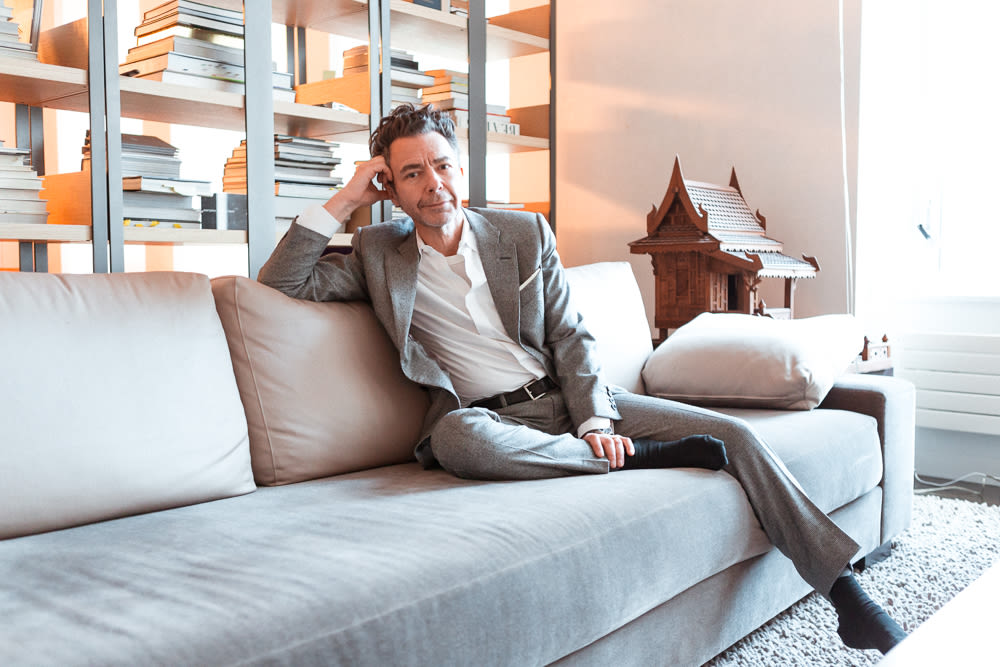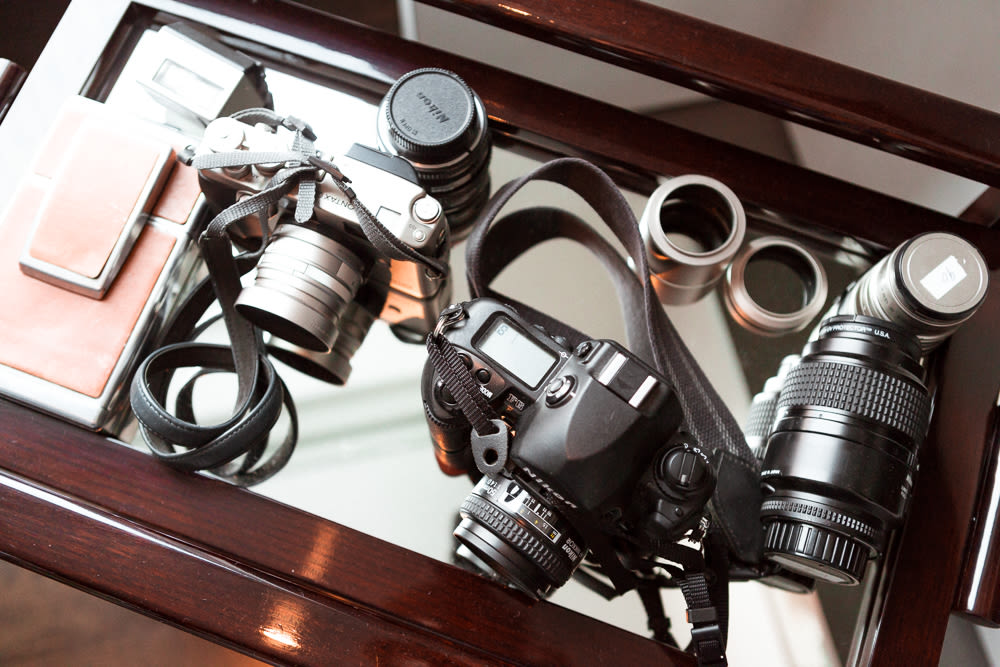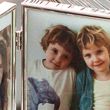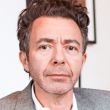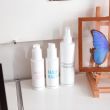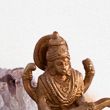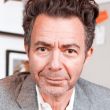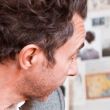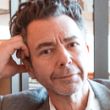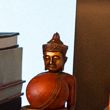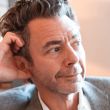'I left school at 15 to apprentice in this salon in London—this was in the mid-1960s and things were changing. The culture was moving from this older world into this newer world of arts and music, and everything was exploding. I had no interest in hair, but I didn't know what else to do—I wanted to be a race-car driver, I just didn't know how to make that happen. But I hadn't excelled in anything at school, and my mother did hair, and we had a comfortable income, so I became a hairdresser. I was this kid working in an extremely prestigious salon with women who were just breathtaking. My education really came through listening to them talk about their world, and then I discovered magazines. I read American Vogue, which was much more powerful during those days. Between the magazines and the people who were coming in, I was learning about how to create an aspirational, innovative, exciting culture and ambience.
There was another salon that was the hottest place in London, called Leonard of Mayfair. It was a modern version of the place I trained at—which was more traditional—so I eventually went to go work there. When I was there, one of the hairdressers was leaving to open his own place, and I found myself fantasizing about opening up a salon...Why would somebody want to work there? What kind of clients would it attract? I would casually daydream about those kinds of things—things that I didn't like about traditional salons.
I was 21 at the time, and I thought that someone had to be 30 to be successful, so I was like, how am I going to get there? I was addicted to yoga at the time, and I'd visited Johannesburg, South Africa the previous year and loved it, so I decided to move there to study yoga. While I was down there, I decided to open a salon, which would support me while I studied. The salon was called Bumble and bumble, and in five years we moved around to three different locations until we settled somewhere.
[The name] Bumble was kind of like a joke. It was like, I trained at the house of Renée, which was very serious, and the house of Leonard, which was also very serious. They were kind of uncomfortable and pretentious-sounding, so I would never have put my name on something. Whereas Bumble is disarming, in an illogical kind of way. If you’re a schoolteacher or a housewife and you walk into the house of Leonard, you feel like you don’t really belong there. Bumble made it OK for everyone and that’s what I like. In the '60s there were the Beatles and the Stones, and there was this irreverent postwar kind of fuck-you-who-gives-a-shit sensibility. It was charming. So that was the name. We had just moved to the third location—some of my clients were interior designers and had designed it, and it was fantastic—but I decided to leave Johannesburg at that point. I wanted to make things better...it was never good enough. I wasn’t dissatisfied, I just wasn’t satisfied.
In the '70s, somebody convinced me to come to New York, saying that it was the best place to go...but it was the worst place. I came here, didn’t know anybody, and bought a dump on 57th Street. That was hairdressers row and I was the guy who came from nowhere. It was a very old-fashioned-looking space, so I painted it and tried to make it look better. After about a year and a half later, we got a write-up in Vogue and in the newspaper, and suddenly I was really busy. My strategy was different than most places—it was about having a downtown atmosphere, but uptown. And we were much more affordable than the other uptown salons. Bumble was just a different culture.
We kept getting more and more publicity, and I was always attracting people to do editorial for us. One of the people we had at that point was Orlando Pita. I would watch him work and I started thinking, ‘We need to make products that he wants to use.’ So I decided we would make six or eight products. There was the Seaweed Shampoo and Seaweed Conditioner, which still exist, and then we had Brilliantine—editorial people liked it—and the Thickening Spray, which was kind of starchy. What was not traditional was that most hair companies made their bread and butter from shampoo and conditioner, but we were the reverse—it was all about style. It became hip to get your hair done at Bumble, and then the products just took on a life of their own. There were a few products in 1992, but we became Bumble [the company] in 1996. At that point, we were on Estée Lauder's radar—they were already buying up Aveda and MAC. Leonard Lauder called me one day—he was very charming, and I thought, 'OK, that's good'—and in 2000 he bought a majority stake in Bumble.
In 2003 we were building our place on 13th Street, and that was something that really annoyed Estée Lauder. I didn’t use their realtor and instead used a downtown broker that I liked, so they were pissed off about that. They were like, ‘What are you doing on 13th Street with all these meat people?’ I thought it was great! We would just do things that other companies didn’t do. But at some point there’s a resentment that’s built-up because I wouldn’t fill in expense reports, I wouldn’t do all the things they did, or go to their parties. I needed to leave and do something new.
After I sold the rest of my shares, I rested for a while. When I came out of hibernation, I decided things should be different. So I started a new line of products, Hairstory. I had a sneaking suspicion that something was up with shampoo. I kept saying, ‘Can you make it gentler?’ Nobody even thought it was possible to do. The thinking was that Bumble had 15 shampoos that were basically all the same. Why does L’Oréal have 30? Why do they have conditioners? Why do they have all this stuff? Because they think they'll sell more. Nobody needs all these products—nobody needs shampoo, but hair companies all have the same silly marketing plan and they copy each other, so there’s nothing original. All shampoo, from $2.99 to $100, is essentially water and sulfate and stuff. The ‘stuff’ is meaningless, it’s fragrances.
Detergent is bad for your hair and bad for your scalp and it is the cause of why you need to use conditioner and why you need to add stuff to give it some body...It's this cycle. If you don’t use detergent on your skin, why would you use it on your scalp? Your scalp is even more sensitive. After the area underneath the tongue, it’s the most absorbent area in your whole body for toxins. We have oils which gently remove accumulation, and then your hair feels fantastic without the conditioner because you didn’t do the damage in the first place. People responded so well to the Purely Perfect Cleansing Creme, which we launched in 2013, but we wanted to do it better—more memorable name, more reliable packaging, clearer instructions. The whole Hairstory line is based on that, with New Wash as the star product. Then the rest of the line won't be more than six or seven products. Do they work on pretty much everyone in the world? Yeah, they do. Does it mean that they'll be a huge success? I have no idea. That’s what makes me excited.”
—as told to ITG
Michael Gordon photographed by Tom Newton in his home in New York on January 6, 2015.
Discover the careers and trajectories of hair's biggest legends, like Didier Malige and Danilo, in The Professional.
